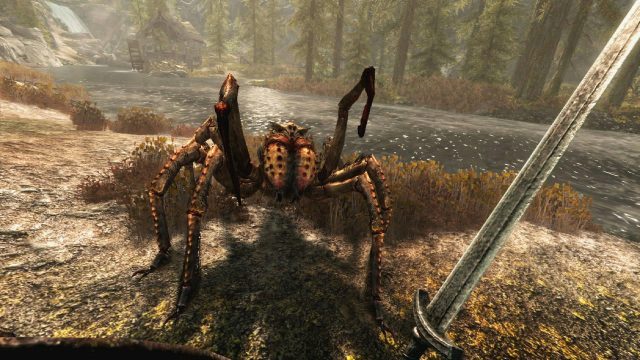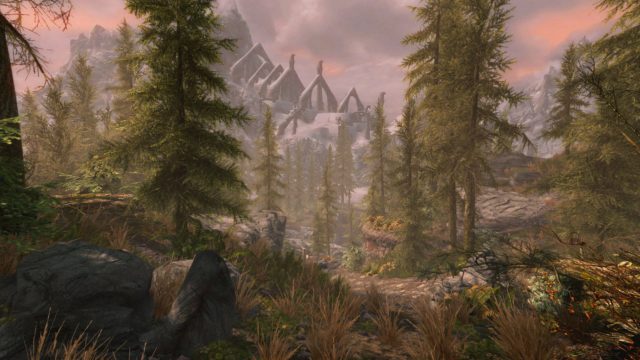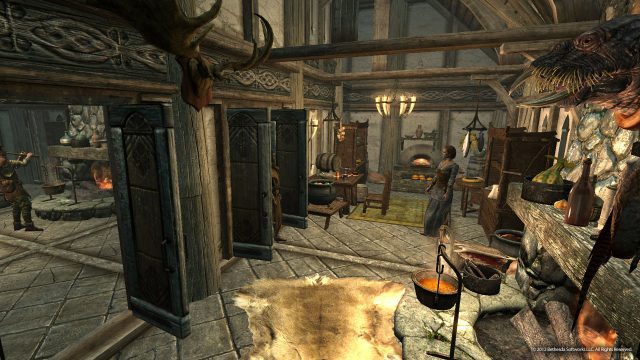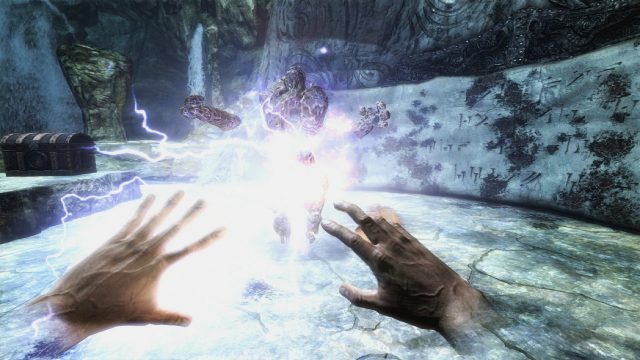Skyrim VR is the first to launch in a series of VR titles from legendary game-maker Bethesda (with Doom VR and Fallout 4 VR soon to follow). The title is effectively a port of the now six year-old open-world RPG Skyrim. The usual wisdom is that VR is so new and so different that it can’t be shoehorned into traditional titles. And while not without its flaws, Skyrim VR challenges that wisdom by bringing a heaping helping of a different sort of immersion.
Skyrim VR Details:
Official Site
PlayStation Store [Digital]
Amazon [Physical]Developer: Bethesda
Available On: PlayStation VR (PS4 Pro)
Release Date: November 17th, 2017
Note: Prior to this review, I’d only played the original version Skyrim for a few hours around the time of its 2011 launch. For all intents and purposes my review of the game comes with the perspective of a brand new player, not a preexisting fan of the game or franchise. I haven’t yet completed the game’s purported 100+ hours of content, as the time since release hasn’t made that possible; this review focuses primarily on the underlying mechanics of the VR implementation upon which the meat of the game relies.
Gameplay
Skyrim VR takes place in a fictional province of the same name, encompassing a classic fantasy ‘medieval + magic’ setting for this monstrous open-world RPG. At the start of the game, you find yourself being transported by carriage as a prisoner alongside some other supposed scoundrels. With your head on the block ready for summary execution, you’re spared an untimely end thanks to a dragon which comes to harass the town. You escape in the chaos, and come to learn that dragons were thought to have vanished, and that their return has something to do with you and your “Dragonborn” bloodline.
At the start of the game you get to pick your race, gender, and customize a wide range of physical features. The dated character models are rather ugly no matter what you pick, but avatar customization is a well-liked feature in the VR space, so this is a natural fit for Skyrim VR.
We spend a lot of time talking in detail about the intersection of game design and immersion when it comes to VR, one aspect of which is agency: your ability as a player to have choice and impact in the world. There’s different types of agency, and while Skyrim VR lacks in many, it positively excels in ‘choice’.
There are many different ways you can play the game: when it comes to combat, you can specialize in melee, ranged, magic, stealth, etc. On top of that, there are extracurriculars you can partake in, like hunting, cooking, smithing, and enchanting, all of which can compliment and define your character choices. You also get to pick what kind of person you want to be in the world—the smooth talking hero who does every good deed; the evil doer whose only goal is acquiring power and wealth; or something in between? It’s really up to you, and you choice is largely cemented simply by doing, meaning that your proficiency in the weapons and abilities that you use most will be the ones that level up. It’s clear that you could replay the game with a vastly different approach and have a different experience. This level of depth is not seen anywhere else in VR gaming to date.
Bethesda has retooled the game’s combat controls to work with the PS Move motion controllers. In the game the controllers represent your hands—you’ll wield one and two-handed melee weapons like swords, axes, and maces, as well as bows, and magic. For melee, you actually swing the weapons to make contact and damage enemies. A shield in one hand and a sword in the other is a classic combo, and feels good to actually hold your shield up to block attacks and bash enemies. As for magic, you equip a spell in each hand—like fire or electricity—and hold up your hands at enemies to aim.

Skyrim VR combat in not particularly visceral—hitting enemies with melee weapons largely feels like a hit-check rather than a blade slicing into flesh, while casting offensive magic feels like a point-and-hold affair. Skyrim VR’s bows, on the other hand, feel solid as far as immersion goes; using both controllers, you have to knock your arrow, pull it back, and actually aim it (accounting for drop and lead) to land shots. Your aim is really only done with your bow hand, which feels less intuitive and natural than many of the bow implementations we’ve seen in made-for-VR titles, but, functionally, it works pretty well.
It doesn’t come without its kinks however. Enemies usually come straight at you, but without the ability to properly move while drawing your bow, and no way for a quick 180 degree turn, you’ll find a fair bit of awkward shooting, spamming the turn button, running, then spamming the turn button again to face the target and fire more arrows. The same goes for shield wielding—since the free locomotion is relative to your left controller, if you’re holding a shield in your left hand you have to hold it up sideways, so when you try to move you’ll move sideways instead of forward. There’s an option to disable ‘realistic shield grip’ which can help—or you could try switching your shield to the other hand—but it’s a shame to have to compromise your play due to a game’s controls.
There’s a few things you’ll come across that work better or worse than expected. For example, you might think that shooting your bow from horseback would be natural and super cool. Unfortunately the same issue with the shield applies—you’ll get steered off to the side if you try to aim while your horse is moving. You basically have to come to a stop before shooting your arrow. However, it turns out that melee attacks from horseback are really fun. Two-handed weapons will give you the reach you need to catch up to a fleeing bad guy and strike them down with a war hammer to the back of the head. Unfortunately, if it takes more than one swing, you’ll have to cut a sharp turn on your horse to come back around at your foe—a task which feels incredibly awkward with snap-turning.
Which brings me to the game’s locomotion system, offering both teleporting and free locomotion (controller relative), along with snap-turning and a fair set of options to adjust things as needed. I started off with teleportation but eventually found the game more engaging, and thankfully tolerable, with free locomotion (more about this in the Comfort section of this review).
Though Bethesda has done a decent (or at least as good as could be expected) job at porting combat and object interaction for VR, it seems that eliminating the game’s menu-driven gameplay in favor of something more suitable for VR was simply too large a task. You will regularly find yourself digging through menus to access items, weapons, spells, quests, and plenty more, even in the midst of combat. Since the PS Move controllers lack a joystick or D-pad, this is all made more tedious by the need to use the finicky trigger-and-tilt method of simulating directional inputs with the Move controllers. I found the controls unintuitive in many of the menus, forcing me to constantly reference the mappings (which were generally shown somewhere on screen when needed). It took me hours of play time before I started to feel comfortable with what buttons did what. Even then, I still regularly press the wrong buttons and have to look at the mappings.
Menus interactions are the antithesis of VR. Having been exposed to so many VR games at this point, it feels like many steps backwards that I have to dig into a menu to ‘unequip’ a sword from my left hand and then ‘equip’ it to my right hand—rather than simply handing the sword from my left hand to my right hand. And instead of being able to holster my favorite weapons, I have to pull them out with a special favorites menu (which requires me digging into another menu to favorite and unfavorite items).
Immersion

While Skyrim VR’s non-VR roots lead to sometimes glaring reductions in immersion, there’s another part of the immersion equation which the game does like no other to date: the depth of the world. We usually talk about immersion with regards to a feeling of physically ‘being there’, with sights and sounds being the key to convincing you. It’s one thing, however, for a virtual character to appear like it’s psychically ‘really there’ in front of you, but it’s another thing entirely to feel like that character exists in a broader universe that you’re standing in.
The game world feels truly massive compared to anything else available in VR right now, both in physical scale and depth of content. Being able to walk into any random house or tavern and see them populated with people—all with fully voiced lines—solidifies the world immensely. It was fascinating to simply walk into a town and watch as a character operated a saw mill. Just one detail among many littered throughout the game.
This depth drastically lowered my pace through the game; I’m not a huge RPG player, but feeling like I was standing in the massive world of Skyrim made me more interested in engaging characters in optional conversations to learn more about what’s going on in this reality. It also impacted how I felt about what I was doing in the game—since I felt more connected to the world than through a flat screen, I didn’t feel the urge to try randomly killing villagers or to steal their stuff just for the hell of it—I felt encouraged to hold up my part in the role-playing.
This extends to items and objects too. Although object interactions are hardly more than point and click, the fact that the world feels so full of ‘real’, often useful stuff makes it feel surprisingly solid. For instance, I was on my way from one town to another when I stumbled upon a random shack in the woods. Hopping off my horse to investigate, I found that no one was home. Even so, inside the shack were shelves full of objects that I could use or steal, a fully readable journal laying next to a bed that I could choose to sleep in, and a small garden out back with plants that I could harvest for later use. Both the fact that the items existed there, and the fact that I could make use of them elsewhere in the world, made even this random shack feel a lot more real than if it had just been an empty building.

Visually the game feels quite dated—to be expected from a 2011 title that wasn’t the top of its class even at the time. Even playing on PS4 Pro, which Bethesda says uses some supersampling compared to the PS4 version, it feels like details just 15 feet fall off drastically in quality, turning into an aliased mess. Large distant terrain often fares better than regions of high spatial detail (like nearby bushes and trees). There are occasional moments of beauty in Skyrim VR, especially from the gorgeous skybox and vistas that make you realize how damn big the world is that you’re standing in; but for every moment of beauty there’s also one of pretty glaring crap graphics, with somewhat distant towns devolving into completely unrendered fields and clearly repeating textures. Smaller spaces like building interiors and dungeons fare better, and effects like dust, burning candles, falling debris, and flowing water add visual interest. Thankfully Bethesda was able to fix a weird ‘squished depth’ issue that I had seen in pre-release hands-ons with the game.
Frequent loading screens between doors to most houses, towns, and dungeons was an unfortunate immersion breaker, even though they were pretty quick in most cases. I would have preferred to simply be frozen in place, at least able to still look around and hear the world, until the next space loaded, rather than fading to a black screen for several seconds.
The game’s generally ugly character models have serviceable animations, but janky transitions often ruin your suspension of disbelief, especially that of the would-be menacing dragons. One redeeming quality is that characters will maintain eye-contact for the most part, no matter where you move your head. Another is that characters subtly comment on you as the player—referring to you by gender and race, and sometimes by your actions. I was playing as a female Wood Elf, and occasionally characters would greet me as “Sister,” or say that they were glad to see another one of their own race (referring to me). Hearing people talk about your character (which you got to design) communicates how they perceive you, and in turn reinforces your presence in the world in a really cool way—one that I hadn’t quite appreciated until playing Skyrim VR.
There’s a number of unfortunate and seemingly obvious immersion missteps in the game. For one, when your weapons are sheathed, you literally see 3D models of the PS Move controllers in place of your hands. This feels totally out of place in the game’s fantasy setting. At the absolute minimum they could have textured the controllers to look like wood rather than plastic. Better yet, they should have swapped the models out with something that was more fitting, maybe like a wand, on even just hands. The only conceivable reason to show the models as they did was so the player could see the buttons on the controllers to assist with all the button-based menus, but there’s a million ways they could have achieved that objective while making the controllers feel like less of an utter anachronism. And even so, the buttons as rendered on the controller models are so small and dark that I often strained to see them. They absolutely should have been made larger and brighter for easy reference. Furthermore, when the game’s hand-models do appear, they are often poorly aligned to your actual hand position, making them not feel much like your own hands.
Comfort
Since I’m usually sensitive to free locomotion, I initially opted for teleportation. This worked well enough but felt a little slow and not particularly immersive. So I gave the free locomotion a shot and found that the reduced FOV during movement was astoundingly effective at keeping me comfortable, even during situations that should by all accounts make me nauseous. For instance, running up a flight of stairs causing my character to rapidly bump up and down, jumping, and even riding horseback as the movement of the horse moved my head up and down. I didn’t have any moments during the game where I felt nausea (except briefly in the ‘god-view’ map) though as ever your mileage may vary. There’s an option to turn up the FOV reduction while moving, so if you’re having trouble feeling comfortable in Skyrim VR definitely give that a shot.
I opted to play the game standing for the most part, which worked fine, and I was also able to play seated when I needed a break—the game automatically calibrates to a standing height, even while you’re seated.

Much of the game’s persistent UI elements have been stripped out, though the Compass bar remains (look down about 45 degrees to see it). This is actually great because it acts to mark your real-world forward direction which helps you maintain the optimal position facing the PS Camera. Health, Mana, and Stamina bars appear above the compass as needed during combat, but they can be a real pain to see in the heat of battle. I often found myself straining to find my health bar while running away from an enemy to see how much damage I’d taken.







